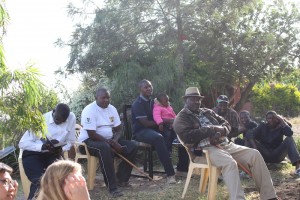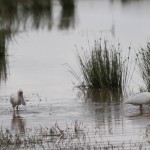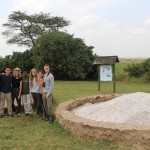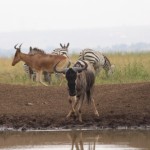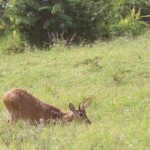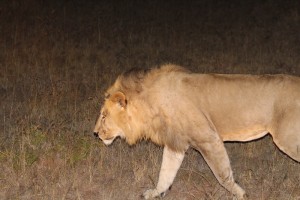The journey back to Nairobi was predictably long, but not without its fair share of excitement and intrigue. The third female member of the group, like to play daisy slots and other casino games is now taking part in a new journey, Zheng, was sold for an impressive 20 camels (which Brendan attempted to push to 200, without success). This came much to the disappointment of Louise, now the final single lady, and she began to worry that the rest of the trip would be spent in despair as a lonely spinster. As we’ll soon find out, however, Enoch had been working his magic to find the perfect Prince Charming.
The following day we met up once again with local chief, Nickson Parmisa, who permitted us to join a local Maasai gathering in Kitengela to discuss their views as pastoralists on human-wildlife conflict and the management strategies implemented by Kenya Wildlife Service (KWS). We decided on the questions to be asked as: 1. What issues do you have with wildlife? 2. What are the benefits to wildlife? 3. What, if any, compensation is offered by KWS? 4. Which species are harming the pastoralist way of life the most?
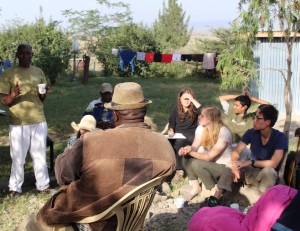
The community was quick to point out that as pastoralists, they had grown up surrounded by animals. The sheep, goats and cows were and still are their bank accounts, and if livestock was predated on by predators such as a lion, the response could only be to kill in order to prevent such attacks occurring again. The lion was an animal that caused economic devastation, and it wasn’t until a collective agreement was reached that this would lead to its extinction, and that tourists were arriving to pay to see the majestic creatures, that the lion’s identity was transformed into a potential economic benefit. The importance of wildlife being seen as something that can improve economic standing has been expressed to us on previous occasions, and hearing it from people directly affected by their presence allowed us to truly understand that conservation cannot focus purely on increasing wildlife numbers, but making sure the local community can also benefit, both socially and economically. To this end, the KWS introduced consolation and a land lease programme.
During the 2003 drought, a huge increase in predation of livestock led to large numbers of lions killed. The lack of water and desperation for the need of sheep, goats and cattle by both lions and humans could only end with humans on top. The consolation programme aimed to prevent this showdown occurring, and now if a cow, sheep or goat is taken by predation, the community receives a sum of money less than the market price of the livestock, but enough to prevent the need to kill the perpetrator. The land lease programme similarly aimed to increase the habitat needed for Kenyan wildlife by paying the community around $4 per acre per year to stop the grazing of livestock on this land.
The Maasai community described the difficulties occurring with both of these programmes, as the total income from the leasing and consolation was far less than the loss from predation, making it economically unviable for the locals. The consolation income often doesn’t trickle down to individual families, and is suffering from a lack of funding, and the lease programme has stopped due to the loss of funding. A further problem with the lease programme was that herders would be fined for moving into any protected areas, yet little was done when wildlife came onto their own land, considering the consolation money proved fruitless. Ultimately, the main issue is considered the leadership of the programmes, with a lack of consideration for the best solutions for pastoralists. The Kikuyu tribe, which focuses on agriculture, dominates the government, thus pastoralism and the Maasai way of life is believed to be hindering their own economic development.
Finally, the group said somewhat surprisingly that the most harming species was the zebra, due to being able to jump the Maasai fences and taking crops vital for livestock success. In this way, the zebra is a core threat to the livestock as a whole, compared to predators such as lions, which may kill a few of the animals, making it a single devastating event. Wildebeest are also an issue by carrying Malignant Catarrhal Fever. With no vaccine and it being easily passed on to livestock, there can be no way of protecting herds – cattle are very vulnerable and it is fatal to them, but it doesn’t affect the host wildebeest. Overall, the Maasai were enthusiastic in their support of the wildlife around their homes, agreeing that although they may not benefit significantly economically, they would never give up the animals that made up such an integral part of their livelihoods and traditions.
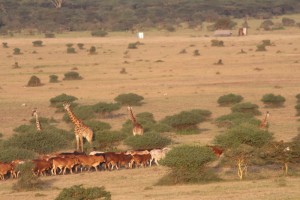

It was interesting to note that only one person at the meeting proposed the fencing of the park’s southern boundary, comparing the situation to the Aberdare National Park, where the park has been completely fenced. This person was an immigrant from another part of the country, and his views contrasted with the more local Maasais’, who knew that this would be disastrous for the wildlife of Nairobi National Park. By confining animals, which would otherwise move with the rains, wildlife would be limited to grazing on land found in the park, and would have no access to the greater variety of pasture located outside the boundaries. At the end of the discussion, Louise was eventually promised to someone’s son (hurrah!), and Enoch could now rest, safe in the knowledge that over half the group would no longer be returning to England. Having rounded up our conversation with the group, we went away feeling much better informed on the impacts of management strategies on the ground. We could now more critically evaluate the successes of the management schemes, previously only heard of from those in charge of the programmes.
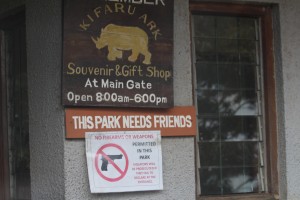
The next day the group traversed Nairobi National Park, with all eyes peeled for rhinos and lions. We were unfortunate not to find any lions, and only glimpsed a black rhino from far away, however for bird lover Tom, the day was filled with much excitement. We were soon stopping at every sighting, including Marabou Stalks and Fischer’s Lovebirds, until the president decreed a ban on stopping for any bird not on his personal list, which excluded anything small and brown. The most exciting sighting of the day was found almost driving over a baby Leopard Tortoise, which had to be rescued and put into the safety of the long grass. From here we travelled to Lisa Ranch (along the way we saw numerous plains game plus a hyena), where the next few hours would test the group’s ability to cope with fear, sleep deprivation and very bad singing.
Lisa Ranch is a 6000-acre (24sq km) ranch owned by Professor Mbithi, ex-Secretary to the Cabinet. It is here that we met Michael, Professor Mbithi’s son, and Akhil, who are running a Lion and Cheetah project within the ranch and wider area of the vast Kapiti Plains, and who took us to our bush campsite to settle down for the night ahead. Once the sun had set, we headed out on a night game drive, using a female lion call to attract the males in the area. We soon met up with Osapuk, a male who has migrated from Amboseli, hundreds of kilometres away, and from here we followed the lion to see it almost make a kill on the neighbouring impala. Having spent an exciting couple of hours following the lion, we were ready to head back to the campsite. Michael’s car, on the other hand, had other ideas, and decided to run out of fuel and break down just before our destination. With 9 of us in the car and only 6 seats, we eagerly awaited assistance and a speedy recovery. This, unfortunately, did not materialise, and instead we were greeted by Osapuk, who encircled the car once Michael left for more fuel. Some of the group handled this better than others, falling asleep and becoming oblivious to the surrounding danger, leaving the rest to descend into delirium, which could be the only explanation for the subsequent rendition of the well-known song ‘Milk a Ferret’ (link song here). After waiting a further 4 hours, we were finally rescued at 4.30am and towed back to base. “Maybe we’ll skip the 6.30am game drive”, Michael suggested. We agreed.
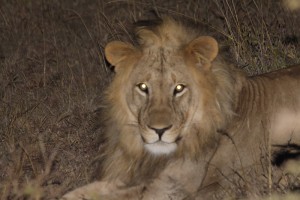
Waking up at 9am (the longest lie-in to date), we went out to find camera traps to see what wildlife existed in the area. We were shown lion, cheetah and caracal, an exciting array of the big cats. Afterwards, Michael told us of the difficulties of owning such a large plot so close to Nairobi. A number of offers had been made for the land, some reaching 5 million Ksh per acre. Such appealing amounts of money was turned down by Professor Mbithi, who insisted that the value of the wildlife, in the present and for future generations, was much greater than anything anyone else could offer. Opposite the ranch, Konza Technology City (nicknamed Silicon Savanna) was in the process of being developed on a similar sized, fully-fenced plot. We could see wildebeest, hartebeest, zebra and Grant’s gazelle inside the fence. At first we considered this to be harmful to the wildlife of the Athi-Kapiti ecosystem, however Michael suggested that the subsequent employment opportunities would lead to fewer poachers in the area. Developments of the railway were also cause for concern, as this prevents the migration of numerous species between Amboseli and Nairobi. Passages have been created beneath the tracks for wildlife to cross the boundary, however as Akhil voiced, this could create hotspots for poachers, who would be able to pick out animals with ease using snares and a scooter for a quick getaway. We left Lisa Ranch hoping that a future visit to Nairobi would be met with just as much wildlife, but with concern as to the compatibility of increased development and conservation.
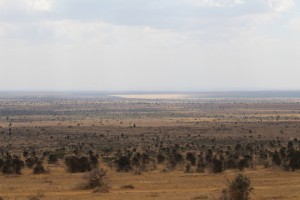
From Lisa Ranch we met up with the founder and senior representatives of Friends of Maasai Mara (FoMM). The members themselves are Maasai, but have become professionals in subjects including law, engineering and medicine. With their expertise, they are now in the position to assist Maasai communities, such as by using a legal team to advise the communities on how to receive consolation from KWS, and by educating people on the reasons for conservation. The group believes there are too many conservancies using alternate management strategies, leading to rivalry and an uneven spread of large lodges, the main way locals are considered to be profiting from wildlife. This was a new perspective of conservation in Kenya, with previous discussions with managers of the conservancies focussing on the advantages and difficulties of their schemes, rather than an issue with conservancies themselves.
After meeting with FoMM, the group was promised a meal in one of the excellent Chinese restaurants of Nairobi. Having left after 9pm, we were soon disappointed and surprised to find that every restaurant was closed, and we began to consider Nakumatt (a supermarket) as our only option. We were eventually rewarded with the only available restaurant, the Sarova Stanley, also one of the finest hotels in Nairobi. Heading in with walking boots, tracksuit bottoms and greasy hair, we felt sufficiently under dressed compared to the usual clientele, but tucked in to our non-Chinese food nonetheless. Leaving the restaurant well after midnight, we headed back to Kitengela for another sleep-deprived night, waking up early to reach the next destination of Magadi.
– Claire Gibson
Photo credits: Bhavik

